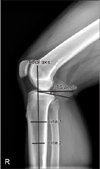Abstract
Purpose
The purpose of this study was to analyze the influence of posterior tibial slope on stability in clinical and second-look arthroscopic evaluation after anterior cruciate ligament (ACL) reconstruction.
Materials and Methods
From 2000 to 2011, 124 patients who underwent ACL reconstruction using an allogaft were enrolled in this study. A posterior tibial slope between 0° and 4° was found in 28 patients (group A), between 5° and 9° in 64 patients (group B), and greater than 10° in 32 patients (group C). We evaluated stability using the Lachman test and a KT-2000 arthrometer. In second-look arthroscopy, grafted tendons were evaluated based on the tension, rupture, and synovial coverage.
Results
In clinical evaluation for stability, mean KT-2000 arthrometer and Lachman test at last follow-up showed no statistically significant differences depending on posterior tibial slope. Second-look arthroscopic findings showed no statistically significant difference between groups A and B (p=0.91). However, statistically significant relations were observed between groups A and C (p=0.03), and between groups B and C (p=0.02).
Figures and Tables
 | Figure 1Posterior tibial slope (PTS) measurement. The PTS angle is defined as 90° minus the angle made by the intersection of the line along the longitudinal axis of the tibia and the slope of the medial tibial plateau. |
 | Figure 2Arthroscopic classification of grafts based on the tension. (A) Taut tension of the grafted tendon. (B) Lax tension of the grafted tendon. (C) Partial tear of grafted tension. |
 | Figure 3Arthroscopic classification of grafts based on synovialization. (A) Good synovialization of the grafted tendon. (B) Half synovialization of the grafted tendon. (C) Poor synovialization of grafted tension. |
References
1. Giffin JR, Vogrin TM, Zantop T, Woo SL, Harner CD. Effects of increasing tibial slope on the biomechanics of the knee. Am J Sports Med. 2004; 32:376–382.

2. Fening SD, Kovacic J, Kambic H, McLean S, Scott J, Miniaci A. The effects of modified posterior tibial slope on anterior cruciate ligament strain and knee kinematics: a human cadaveric study. J Knee Surg. 2008; 21:205–211.

3. Hohmann E, Bryant AB. Closing or opening wedge high tibial osteotomy: watch out for the slope. Oper Tech Orthop. 2007; 17:38–45.

4. Dejour H, Walch G, Chambat P, Ranger P. Active subluxation in extension: a new concept of study of the ACL deficient knee. Am J Knee Surg. 1988; 1:204–211.
5. Hohmann E, Bryant A, Reaburn P, Tetsworth K. Does posterior tibial slope influence knee functionality in the anterior cruciate ligament-deficient and anterior cruciate ligament-reconstructed knee? Arthroscopy. 2010; 26:1496–1502.

6. Jung KH, Cho SD, Park KB, Youm YS. Relation between mucoid degeneration of the anterior cruciate ligament and posterior tibial slope. Arthroscopy. 2012; 28:502–506.

7. Brandon ML, Haynes PT, Bonamo JR, Flynn MI, Barrett GR, Sherman MF. The association between posterior-inferior tibial slope and anterior cruciate ligament insufficiency. Arthroscopy. 2006; 22:894–899.

8. Liu W, Maitland ME. Influence of anthropometric and mechanical variations on functional instability in the ACL-deficient knee. Ann Biomed Eng. 2003; 31:1153–1161.

9. Ahn JH, Lee DH, Kim SS. Arthroscopic surgery for the acute anterior cruciate ligament injury. J Korean Orthop Assoc. 1995; 30:291–297.

10. Shoemaker SC, Markolf KL. The role of the meniscus in the anterior-posterior stability of the loaded anterior cruciate-deficient knee. Effects of partial versus total excision. J Bone Joint Surg Am. 1986; 68:71–79.

11. Dejour H, Bonnin M. Tibial translation after anterior cruciate ligament rupture. Two radiological tests compared. J Bone Joint Surg Br. 1994; 76:745–749.

12. Griffin LY, Albohm MJ, Arendt EA, et al. Understanding and preventing noncontact anterior cruciate ligament injuries: a review of the Hunt Valley II meeting, January 2005. Am J Sports Med. 2006; 34:1512–1532.
13. Voos JE, Suero EM, Citak M, et al. Effect of tibial slope on the stability of the anterior cruciate ligament-deficient knee. Knee Surg Sports Traumatol Arthrosc. 2012; 20:1626–1631.

14. Kostogiannis I, Swärd P, Neuman P, Fridén T, Roos H. The influence of posterior-inferior tibial slope in ACL injury. Knee Surg Sports Traumatol Arthrosc. 2011; 19:592–597.

15. Sonoda M, Morikawa T, Tsuchiya K, Moriya H. Correlation between knee laxity and graft appearance on magnetic resonance imaging after double-bundle hamstring graft anterior cruciate ligament reconstruction. Am J Sports Med. 2007; 35:936–942.

16. Kondo E, Yasuda K. Second-look arthroscopic evaluations of anatomic double-bundle anterior cruciate ligament reconstruction: relation with postoperative knee stability. Arthroscopy. 2007; 23:1198–1209.

17. Otsubo H, Shino K, Nakamura N, Nakata K, Nakagawa S, Koyanagi M. Arthroscopic evaluation of ACL grafts reconstructed with the anatomical two-bundle technique using hamstring tendon autograft. Knee Surg Sports Traumatol Arthrosc. 2007; 15:720–728.

18. Paulos L, Noyes FR, Grood E, Butler DL. Knee rehabilitation after anterior cruciate ligament reconstruction and repair. Am J Sports Med. 1981; 9:140–149.

19. Shelbourne KD, Nitz P. Accelerated rehabilitation after anterior cruciate ligament reconstruction. Am J Sports Med. 1990; 18:292–299.

20. Corry IS, Webb JM, Clingeleffer AJ, Pinczewski LA. Arthroscopic reconstruction of the anterior cruciate ligament. A comparison of patellar tendon autograft and four-strand hamstring tendon autograft. Am J Sports Med. 1999; 27:444–454.
21. Irrgang JJ, Harner CD. Contents recent advances in ACL rehabilitation: clinical factors that influence the program. J Sport Rehabil. 1997; 6:111–124.




 PDF
PDF ePub
ePub Citation
Citation Print
Print






 XML Download
XML Download